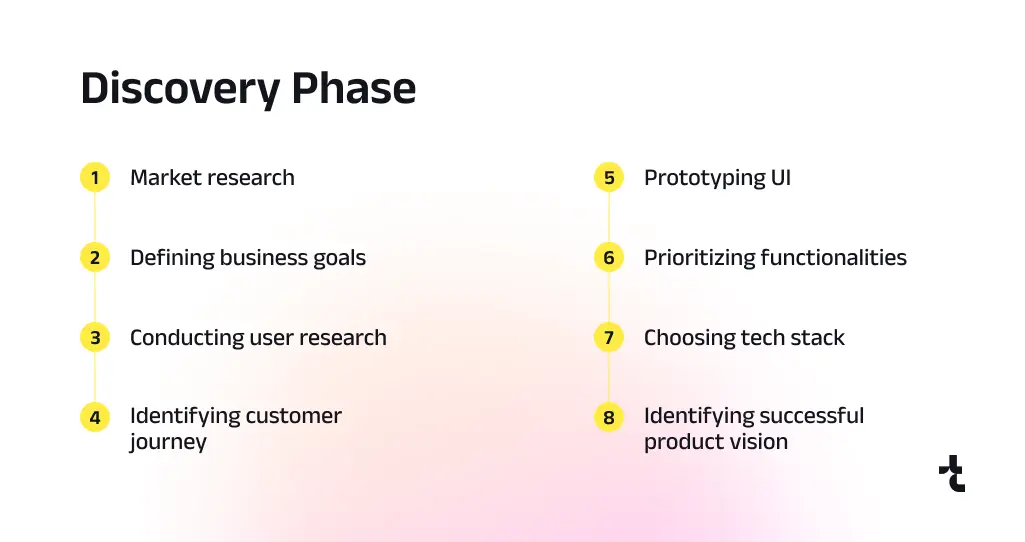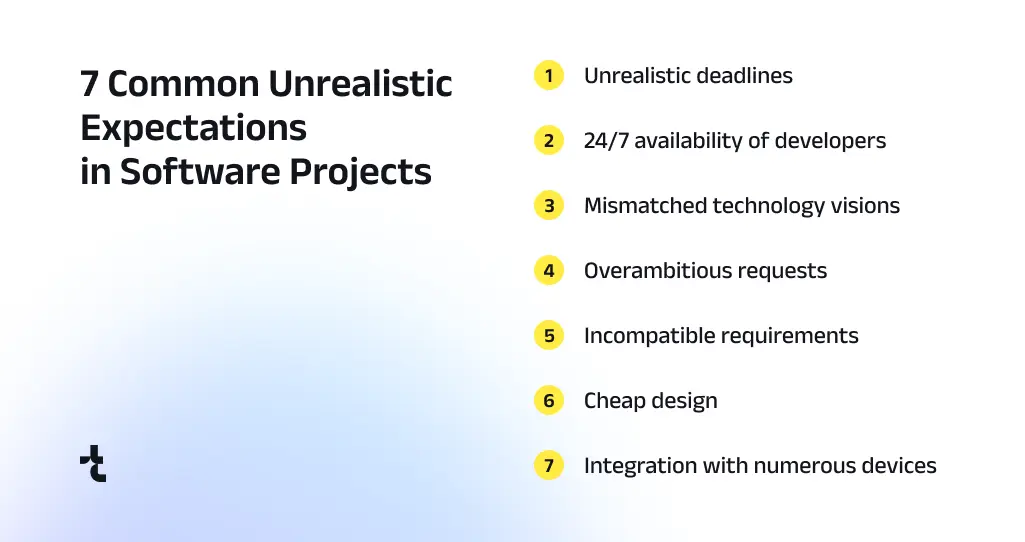Key Expectations and Pitfalls in the Project Discovery Phase
The discovery phase is a vital time when clients and development teams come together to share their dreams and expectations for a successful project. It’s all about teamwork and understanding each other’s vision to create something truly amazing. Of course, sometimes this phase comes with its own set of challenges, like tackling those tricky, seemingly impossible requirements.
No worries, though, we’re here to guide you through the heart of the discovery phase, highlighting its significance and offering strategies to handle and adjust any unrealistic expectations smoothly.
Read on to learn how to make your project a shining success from the start.
What is the project discovery phase?
The discovery phase is the first step in the software development lifecycle.
It’s a time for you and the development team to understand and write down what the project needs, aims to achieve, and what limits there might be.
You’ll have deep conversations to make sure everyone agrees on the plan before any real building starts. It helps everyone have the right expectations, look at different options, and create a practical plan for your project.
During the project discovery stage, you’ll gather all the important market and user research data you need to make good choices. You’ll decide on things like:
- Design style
- Features for the first version of the product
- Best technology to use for the product
In the end, you’ll usually have such discovery phase deliverables as a UI prototype, some documents, like a project roadmap, and a clear vision of what success looks like for your product.
Why have a project discovery phase?
Project discovery is really important for a few key reasons. First, it helps figure out exactly what the project is about and what limits it might have, stopping any unexpected changes and keeping things on the right path.
Second, it ensures everyone understands what you need and want, which matters a lot for making a product that fits those needs.
Third, it’s a chance for the development team to tell you about what can and can’t be done technically, helping make a feasible plan.
In short, the discovery stage is when your knowledge and the tech team’s knowledge come together. You both have important things to share and decide on before putting time and money into the project.
Although every project is unique, we’ve compiled a list of the most common unrealistic expectations that can slow things down. Check out this list to stay ahead from the start and keep your project on the path to success.
Unrealistic expectations that can disrupt your product development
It’s not unexpected that the most common unrealistic expectations are about the project’s roadmap, mismatched visions, and communication issues. As you review them, you’ll see why it’s best to address each issue right from the start of the project.
#1 Unrealistic deadlines
We often see impossible timelines. They come from not understanding the complexity behind the tasks and believing that adding more people can shorten the development time. However, some processes just can’t be expedited with 300 developers and need more realistic timelines.
We’ve witnessed people misleadingly believe that a complex system can be delivered in two months with just more people. Unfortunately, it’s not how things work.
# 2 24/7 availability of developers
Some clients might think developers should be available all the time. This isn’t effective most of the time and can cause burnout. It’s important to be clear about when developers can work and contribute. If you believe you need support all the time, you should be ready to allocate more budget for that or look for a team that works in different time zones to cover the whole day.
#3 Mismatched technology visions
You might have some popular technologies in mind that you want to use, and that’s great. But it’s important to figure out if the tech stack you mean even fits your product idea. Often, clients prefer to contact consulting agencies first to find out what kind of stack they need. However, with no hands-on experience, agencies tend to refer to the most widespread technologies, too.
#4 Overambitious requests
Requests for AI development services without a clear understanding or provision of necessary algorithms are common, too. Again, the vendor team is the one to communicate this issue with you closely and define realistic technologies to serve your users.
One day, we discussed a medical AI-based system that would independently match patients with the recommended treatment. However, the client lacked a vision of the concrete algorithm to complete the task. What we’re trying to say is that when we have such a big gap in business logic, the discovery phase is the right time to close it together.
#5 Incompatible requirements
You may want everything under the sun — high-quality video recognition, unlimited storage, and instant access worldwide on a limited budget. It’s important to navigate these requests carefully, prioritizing and finding workable solutions.
A good example is when you work with multimedia, such as video content. You may want to store your content forever and have real-time access because it seems valuable. It’s obviously a costly thing to do. Here, it’s better to know exactly how often you need to refer to this or that content and make the right storage and access decisions, especially if you are tight on budget.
#6 Design on a dime
Sometimes, people from different fields might not realize how fundamental the design phase of a project is and think programmers can just take care of it. But the user interface is the first thing users see, and developers may just lack this visual taste you may want to communicate to your end-users. Skimping on design could make it hard to attract users and sell your product.
#7 Integration with numerous devices
Clients might ask for their product to work with lots of different devices, but this can make things much more complicated and expensive. A smarter way is to figure out which devices are primary for your users and focus on those first.
One of the client requirements we can recollect is the need to integrate with all types of smartwatches and bracelets to track sleep quality and movement data. As a result of a thorough discovery, we decided to go for some Samsung and Apple models only because they were more common choices by the target audience.
You’ll see that the entire discovery phase is about making the best use of your budget and time and improving the product instead of just pushing what one side wants. Through open and clear communication, you can find common ground that meets all your needs and sets the stage for a successful project.
How much does discovery phase cost?
The cost of the project discovery phase can vary significantly depending on the project’s complexity, your needs, and the team’s expertise. However, adopting a shift-left approach, where discovery is seen as an investment rather than a cost, can save time and money in the long run.
By identifying and addressing potential issues early, you reduce the likelihood of costly mid-project changes and ensure a smoother development process.
Set the stage for a realistic project delivery
As we’ve journeyed through the twists and turns of the discovery phase of a software project, it’s clear that understanding and managing expectations is the key to a smooth, successful delivery. Remember, every hurdle you clear and every detail you nail down now is a step closer to bringing your vision to life.
So, if you’re feeling overwhelmed by the challenges or just need a guiding hand to help navigate these crucial early stages, Timspark is here for you. Our team is dedicated to turning your ideas into reality, and we’re just a message away.



